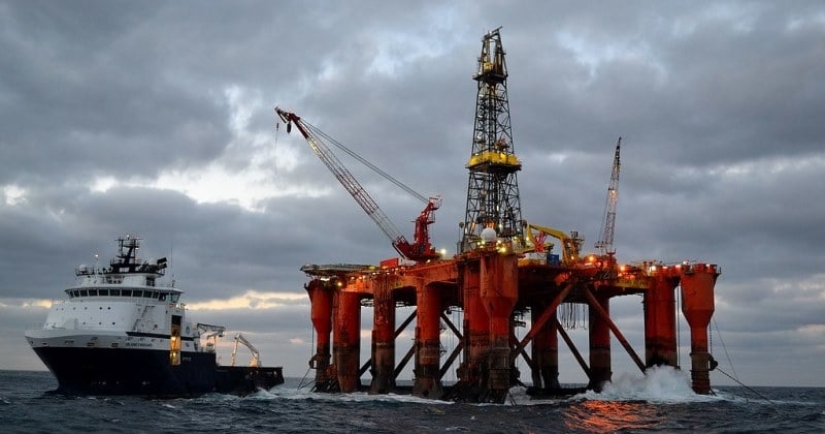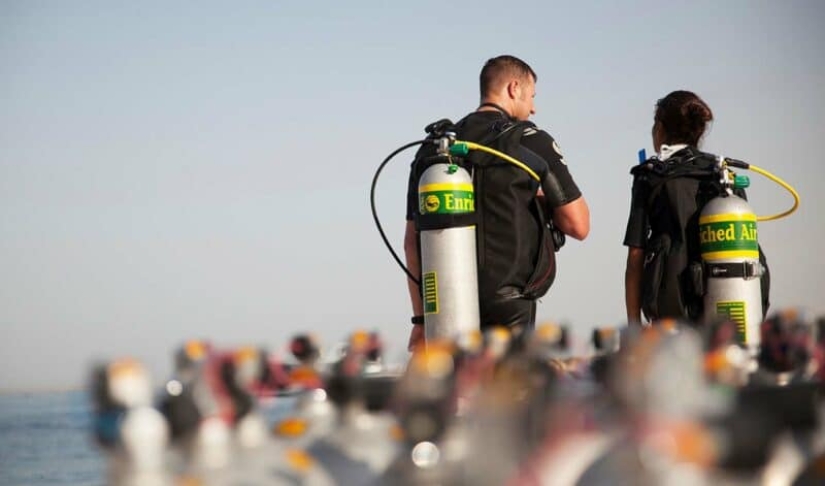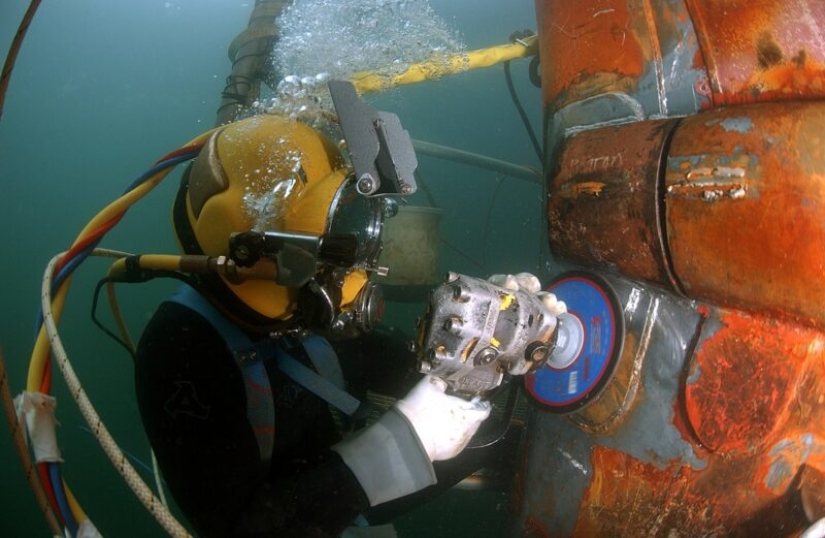The tragedy on the Byford Dolphin platform, the worst death in the workplace
If you think that your working conditions leave much to be desired, then you definitely need to get acquainted with such work as immersion with saturation. This is not only the highest paid physical labor in the world, but also the most dangerous. Submariners of this specialty work on oil and gas platforms in the open sea. Usually for such work they receive from 1400 US dollars a day. But believe me — they get this money for a reason. After all, these people risk dying a terrible death every minute.

Imagine that you are in a tight metal pipe under water, at a depth of more than 100 meters, and around it is dark and cold around zero degrees. You breathe a mixture of gases and are constantly freezing, and food is passed to you through a small window. You only have a few hours of rest between exits into the abyss. And there, at a depth under water, you have to twist nuts and work with welding. And this is not a description of one day. So you need to live and work for months, because climbing to the surface is deadly.

Saturation diving is a way of working at great depth. It was developed by the US military in the 1960s as part of the Sealab program of the US Navy. The main task of the specialists was to overcome the danger of decompression (caisson) disease. And it has always been and remains one of the main causes of death of divers.
When a person inhales compressed air at a depth, the nitrogen it contains is dissolved in the body. But with a rapid rise to the surface, a sharp decrease in pressure can cause the formation of nitrogen bubbles in the blood. They cause unbearable joint pain, stroke, paralysis and often cause death.
To avoid this danger, submariners rise to the surface slowly. They make decompression stops so that nitrogen leaves the body without causing harm. This method is good for short-term dives. But if a diver has to do work at depth, it is impractical. In this case, a highly paid specialist will spend more time gradually rising to the surface than performing his duties.

To dive to a depth of 100 meters, it takes 50 hours of decompression. Nowadays, it is carried out in special caisson chambers with gradually decreasing pressure. When diving with saturation, divers are submerged for several weeks. They perform the tasks assigned to them, and rest in special underwater chambers with high pressure.
It doesn't matter how long a person is at depth. Decompression always takes the same time. Therefore, at the end of their long watch, divers rise to the surface in a sealed case. After that, they are decompressed only once in a special chamber. So the risk of caisson disease and other dangerous conditions that threaten divers is minimized.
Underwater specialists face many dangers. Among them is nitrogen poisoning or disorienting euphoria, which occurs when inhaling nitrogen at depth. This condition is very similar to alcohol intoxication. It can cause inappropriate behavior of the diver and even loss of consciousness.
It should be added that at depths of more than 80 meters, oxygen becomes toxic to humans. Therefore, divers use the so-called trimix for breathing. It is a mixture of gases in which helium is used instead of oxygen. This gas cannot be called an ideal substitute. And all because it causes heat loss due to which divers are constantly freezing.
In addition, helium changes a person's voice beyond recognition, making it very thin. To understand the speech of divers, special decoders are used. At a depth of over 300 meters, helium becomes potentially dangerous. It causes a neurological effect known as high pressure syndrome.
But these are not all the risks that divers take when diving to great depths. The biggest danger when diving is a high-pressure environment. In 1983, a tragedy occurred on the Byford Dolphin semi-submersible drilling platform. As a result, it has changed the safety regulations of divers around the world.
The Byford Dolphin platform was built by Aker Engineering in Oslo in 1974. It was a real giant, weighing 3,000 tons, which was serviced by a team of 100 people. The unique equipment allowed the installation of the platform to drill the ocean floor at a depth of 460 meters. But for the smooth operation of the system, professional maintenance and repair in the underwater part was necessary.
For divers working for Byford Dolphin, the French company COMEX has created a saturation diving system. It was considered revolutionary for the 80s of the last century. The equipment worked flawlessly until November 5, 1983. But it was on this day that the human factor led to a terrible accident with human victims.
The drilling platform was drilling at the Frigg gas field in the Norwegian part of the North Sea. At 4 a.m., two British divers, Edwin Coward and Roy Lucas, were resting in a decompression chamber on deck. At that time, two Norwegian divers, Bjorn Bergersen and Truls Hellevik, were returning to the surface in a displacement capsule.
Operators William Crammond and Martin Saunders removed the capsule with the Norwegians from the water and docked them to the camera with the British so that they could join them and begin a long decompression procedure. Bergersen and Hellevik crossed the short section to Coward and Lucas. After that, the divers had to close the airlock and seal the chamber before the operators released the pressure and disconnected it from the capsule.
But Hellevik hesitated and did not have time to close the hatch of the camera. Meanwhile, operator Crammond disconnected the capsule from the airlock. The pressure in the capsule dropped from nine atmospheres to one in a fraction of a second. Breaking away from the camera, she dashed like a torpedo across the deck of the drilling platform.
Crummond died on the spot, and his partner Saunders was seriously injured. The Hellevik who was in the compartment was simply torn apart and his remains scattered far across the deck. The other divers who were in the cell died instantly. Autopsies of the bodies of Coward, Lucas and Bergersen showed that their veins and arteries were clogged with clots of white matter. These were proteins that had coagulated due to the boiling of the blood caused by the pressure drop.
Experts believe that the divers died without even having time to understand what happened, and did not suffer before death. The investigation of the incident on the Byford Dolphin platform showed that Krammond was to blame for the deaths of people. It was he who released the clamp before the divers sealed the camera hatch. Since the operator was killed, there was no one to make a claim. It remained only to draw the appropriate conclusions.
The COMAX saturation diving system used on the drilling platform did not have any safety devices to prevent an accident in the event of an emergency. Investigators suggested that Krammond made the mistake not because of negligence, but because of overwork and exposure to external factors, such as noise on the platform deck.
One of the main culprits of the emergency were the heads of Byford Dolphin technical services, who, contrary to the instructions of the Norwegian oil and gas regulator DNV, did not equip the cameras and capsule with safety devices and pressure gauges. But, as it often happens, the dead workers were made to blame for everything. As a result, their families did not receive any compensation.
The relatives and friends of the victims did not accept this. They created the North Sea Divers Alliance, which has been seeking a fair decision in court for many years. It was only in 2008, a quarter of a century after the tragedy, that it was possible to obtain a confession of guilt and compensation from the owners of Byford Dolphin.
The Byford Dolphin drilling platform was operated until 2019 and saturation diving was practiced on it, as before. But a case that happened almost 40 years ago forced the managers of the company that owns the platform to reconsider the rules for using cameras and equip them with security systems. Now it is a new standard all over the world, slightly reducing the risk of the already dangerous work of divers.
In general, any work on a drilling platform can be considered dangerous, since there are a variety of accidents on these structures. Most often they suffer from fires, which, in conditions of complete isolation on the high seas, pose the maximum threat to personnel.
